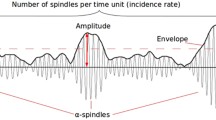Abstract
Following one base-line session, 20 normal subjects received four half hour sessions consisting of simultaneous feedback of heart rate and frontalis muscle (pretraining). Ten subjects received contingent (CF), the other ten noncontingent feedback (NCF). Subjects were asked to lower heart rate and frontal muscle tension (EMG). Heart rate within sessions decreased up to 19 bpm, with a mean of 4 bpm for the CF group. There was only a weak decrease over sessions, however, because of the strong habituation effect. The following events accompanied the heart rate decrease: (1) an increase of the variability of the heart rate, (2) a decrease of the variance of the EMG, (3) an increased correlation between heart rate slowing and EMG decrease, and (4) an increasing subjective experience of control of heart rate and EMG. After pretraining, subjects received eight sessions of auditory feedback of their frontal EEG theta activity (four sessions with CF and four sessions with NCF in balanced order). There was a weak increase of theta for the CF condition over sessions, but a decrease within the sessions. Pretraining on heart rate and frontal EMG control had no influence on the performance during theta training. It was hypothesized that control of heart rate slowing and theta control involve different mechanisms.
Similar content being viewed by others
References
Beatty, J., Greenberg, A., Deibler, W. P., & O'Hanlon, J. F. Operant control of occipital theta rhythm affects performance in a radar monitoring task.Science, 1974,183, 871–873.
Beatty, J., & Kornfeld, C. Relative independence of conditioned EEG changes from cardiac and respiratory activity.Physiology and Behavior, 1972,9, 733–736.
Blanchard, E. B., Young, L. D., & Jackson, M. S. Clinical applications of biofeedback training.Archives of General Psychiatry, 1974,30, 573–589.
Brown, B. B. Awareness of EEG subjective activity relationships detected within a close feedback system.Psychophysiology, 1971,7, 451–467.
Edwards, A. L.Versuchsplanung in der psychologischen Forschung. Weinheim: Beltz, 1971.
Fahrenberg, J. Ein Fragebogen zur Messung der vegetativen Labilitat.Diagnostica, 1965,1, 1–15.
Good, R. Frontalis muscle tension and sleep latency.Psychophysiology, 1975,12, 665–667.
Klug, J. W., & Brown, B. B. Learned control of EEG theta activity. Paper presented at the Annual Meeting of the Biofeedback Research Society (BRS), Colorado Springs, 1974.
Lang, P. J. Learned control of human heart rate in a computer directed environment. In P. A. Obrist et al. (Eds.),Cardiovascular psychophysiology. Chicago: Aldine, 1974. Chicago: Aldine, 1974.
Lienert, G. A.Verteilungsfreie Methoden in der Biostatistik. Weinheim: Beltz, 1974.
Lutzenberger, W., Birbaumer, N., & Wildgruber, C. An experiment on the feedback of the theta activity of the human EEG.European Journal of Behavioral Analysis and Modification, 1975,2, 119–126.
Meyer-Osterkamp, S., Grusche, A., & Cohen, R. Eine Untersuchung zur operanten Kontrolle der Pulsfrequenz.Zeitschrift für Klinische Psychologie, 1972,1, 213–231.
Obrist, P. A., Howard, J. L., Lawler, J. E., Galosy, R. A., Meyers, K. A., & Gaebelein, C. S. The cardiac-somatic interaction. In P. A. Obrist et al. (Eds.),Cardiovascular psychophysiology. Chicago: Aldine, 1974.
Schwartz, G. E. Toward a theory of voluntary control of response patterns in the cardiovascular system. In P. A. Obrist et al. (Eds.),Cardiovascular psychophysiology. Chicago: Aldine, 1974.
Siegel, S.Nonparametric statistics. Tokyo: McGraw-Hill, 1956.
Sittenfeld, P. Die Konditionierung der Theta-Aktivität des Elektroencephalogramms durch akustische Rückmeldung in Abhängigkeit von der Muskelspannung. Inaugural-Dissertation zur Erlangung des Doktorgrades der Mathemathisch-Naturwissenschaftlichen Fakultät der Universität Düsseldorf. Düsseldorf, 1973.
Sittenfeld, P., Budzynski, T., & Stoyva, J. Differential shaping of EEG theta rhythms.Biofeedback and Self-Regulation, 1976,1, 31–46.
Stephens, J. H., Harris, A. H., Brady, J. V., & Shaffer, J. W. Psychological and physiological variables associated with large magnitude voluntary heart rate changes.Psychophysiology, 1975,12, 381–387.
Author information
Authors and Affiliations
Rights and permissions
About this article
Cite this article
Lutzenberger, W., Birbaumer, N. & Steinmetz, P. Simultaneous biofeedback of heart rate and frontal EMG as a pretraining for the control of EEG theta activity. Biofeedback and Self-Regulation 1, 395–410 (1976). https://doi.org/10.1007/BF00998772
Received:
Issue Date:
DOI: https://doi.org/10.1007/BF00998772



